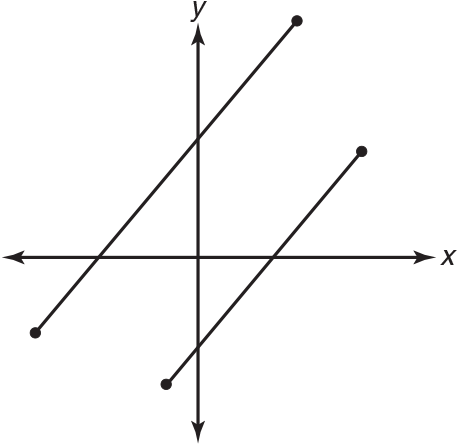Exercises
-
If {(1, 5), (2, 13), (x, y)} is a function, which of the following must be true?
- x > 2
- y ≠ 13
- x ≠ 1
- None
- I only
- II only
- III only
- I and II only
-
If
 , what is the value of f(–8)?
, what is the value of f(–8)?- 78
- 1,530
- 1,542
- 13,818
- 13,830
-
What is the domain of the function
 ?
?- All real numbers
- {x | –2 < x < 2}
- {x | x ≠ 2}
- {x | x ≠ –2}
- {x | x < –2 or x > 2}
-
If
 , what is f(f(x))?
, what is f(f(x))?- 1
-

-

-

-

-
Which of the following graphs is not the graph of a function?
-
-
What is the range of the function
 ?
?- All real numbers
- All real numbers greater than or equal to 0
- All real numbers greater than or equal to 2
- All real numbers greater than or equal to 2 or less than or equal to –2
- All real numbers between –2 and 2, inclusive
-
Which of the following is not the equation of a function?
- y = 3
- x = 3
- y = x
- y = |x|
-

-
-
Question 8 and 9 refer to the following graphs. The first one is the graph of y = |x|.


-
Which of the graphs is the graph of y = |x – 3|?
- Graph A
- Graph B
- Graph C
- Graph D
- Graph E
-
Which of the graphs is that of y = ||x|–3|?
- Graph A
- Graph B
- Graph C
- Graph D
- Graph E

(A)

(B)

(C)

(D)

(E)
-
-
If x ≠ 1, 2, f(x) = x2 – 1, g(x) = x2 – 4, and h(x) = x2 – 3x + 2, then

- x2 + 3x + 2
- x2 – 3x + 2
- x4 – 4
-

-

-
If f(x) = x2 – 1 and g(x) = x2 + 1, what is (f ⚬ g)(x) – (g ⚬ f)(x)?
- –2
- 0
- x4 – 1
- 4x2
- 4x2 – 2
-
If
 , then f–1(x) =
, then f–1(x) = -









